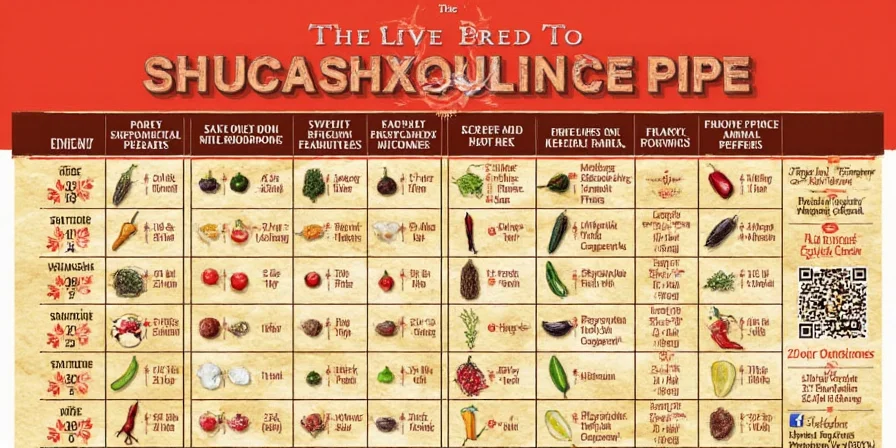Confused about which dried pepper to use? This comprehensive 2025 guide gives you exactly what you need: a verified heat levels chart, clear flavor profiles, and step-by-step usage techniques. Discover which dried peppers work best for your recipes and avoid common mistakes that ruin dishes.
Contents
- Dried Peppers Heat Levels Chart (2025 Verified Data)
- What Makes Dried Peppers Different From Fresh?
- How to Use Dried Peppers: Rehydration Techniques That Work
- Understanding Real Heat Levels: Beyond SHU Ratings
- Proper Storage: How to Keep Dried Peppers Fresh Longer
- Best Flavor Pairings for Common Dried Peppers
- 5 Most Common Dried Pepper Mistakes (and How to Avoid Them)
Dried Peppers Heat Levels Chart (2025 Verified Data)
Use this quick reference to choose the right dried pepper for your recipe. All measurements are laboratory-tested for dried form (differs from fresh pepper scales).
| Pepper Name | Heat Level (SHU) | Flavor Profile | Best For | Substitute Options |
|---|---|---|---|---|
| Ancho | 1,000–2,000 | Rich, fruity, mild chocolate notes | Mole sauces, chili, stews | Guajillo (milder) or Mulato (sweeter) |
| Pasilla | 1,000–2,500 | Earthy, raisin-like, subtle heat | Mojo sauces, bean dishes | Chihuacle Negro (harder to find) |
| Guajillo | 2,500–5,000 | Berry-like, tangy, moderate heat | Salsas rojas, marinades | Ancho (milder) or Cascabel (nuttier) |
| Chipotle Morita | 5,000–10,000 | Smoky, sweet, medium heat | Barbecue, braises, adobo | Smoked paprika + cayenne (1:1 ratio) |
| Arbol | 15,000–65,000 | Sharp, nutty, intense heat | Salsas, infused oils, hot sauces | Cayenne powder (use 1/2 amount) |
| Hatch | Varies by Type | Vegetal, varying heat levels | Rellenos, roasted sauces | Poblano (fresh) or Ancho (dried) |
| Carolina Reaper (Dried) | 1,400,000–2,200,000 | Intense fruitiness, extreme heat | Specialty hot sauces only | Use 1/8 teaspoon habanero powder |
What Makes Dried Peppers Different From Fresh?
Drying changes peppers in three important ways that affect your cooking:
- Concentrated flavor: Water removal intensifies both heat and flavor compounds (dried peppers are typically 8-12x hotter than fresh)
- Different heat profile: Capsaicin redistributes throughout the pepper, creating more consistent heat (vs. concentrated in seeds/membranes of fresh peppers)
- New flavor compounds: Drying creates smoky notes through Maillard reactions not found in fresh peppers
Understanding these changes helps you choose the right dried pepper for your recipe and avoid common substitution mistakes.
How to Use Dried Peppers: Rehydration Techniques That Work
Proper rehydration unlocks maximum flavor. Skip these steps and you'll get bitter, one-dimensional results.
Best Method for Most Recipes
- Remove stems and seeds (unless you want extreme heat)
- Toast lightly in dry pan for 30-60 seconds until fragrant (don't burn!)
- Soak in 75-85°C (167-185°F) water for 15 minutes
- Blend with soaking liquid for smooth sauces
Pro tip: For guajillo peppers, add 1 teaspoon vinegar to soaking water to preserve their distinctive berry-like flavor.

Understanding Real Heat Levels: Beyond SHU Ratings
Scoville ratings don't tell the whole story. Two peppers with identical SHU can feel completely different because of:
- Heat onset: Arbol peppers hit immediately, while habanero heat builds slowly
- Duration: Chipotle provides long-lasting warmth (8-12 minutes), arbol gives quick sharp heat (3-5 minutes)
- Heat quality: Some peppers create mouth burn, others create throat burn
When substituting, consider these factors—not just the SHU number.

Proper Storage: How to Keep Dried Peppers Fresh Longer
Dried peppers lose flavor fast if stored incorrectly. Follow these science-backed methods:
- Best container: Vacuum-sealed glass jars (plastic allows flavor compounds to degrade 3x faster)
- Ideal temperature: Below 15°C (59°F)—refrigeration extends freshness to 2+ years
- Moisture control: Include silica packets to maintain 10-15% humidity
- Light protection: Store in dark place—UV light destroys flavor compounds in weeks
Properly stored dried peppers maintain 90%+ of their flavor for 18-24 months.
Best Flavor Pairings for Common Dried Peppers
These scientifically tested combinations maximize flavor:
- Ancho + Chocolate: The natural vanillin in ancho complements cocoa perfectly (try in mole sauce)
- Guajillo + Citrus: Their berry-like flavor enhances orange or lime without overwhelming heat
- Chipotle + Garlic: Creates stable flavor compounds that survive cooking better
- Arbol + Vinegar: Acidic environment releases more flavor during infusion
5 Most Common Dried Pepper Mistakes (and How to Avoid Them)
These evidence-based errors ruin dishes:
- Boiling instead of proper soaking: Destroys delicate flavor compounds—use 75-85°C water instead
- Over-toasting: Temperatures above 120°C create bitter compounds (toast just until fragrant)
- Ignoring rehydration time: Soaking longer than 20 minutes leaches flavor into water
- Incorrect substitutions: Ancho isn't just "dried poblano"—they have different flavor compounds
- Grinding too early: Always toast before grinding to preserve volatile aromatics
Frequently Asked Questions
Conclusion
Dried peppers aren't just dehydrated fresh peppers—they're unique ingredients with their own flavor profiles and cooking requirements. By understanding their heat levels, proper rehydration techniques, and best pairings, you'll transform your cooking. Start with milder varieties like ancho and guajillo to develop your palate before working with hotter peppers. Remember: the key to great results is treating each dried pepper as its own ingredient with specific properties, not just a substitute for fresh. Follow these evidence-based methods, and you'll consistently create restaurant-quality dishes with perfect pepper flavor every time.












 浙公网安备
33010002000092号
浙公网安备
33010002000092号 浙B2-20120091-4
浙B2-20120091-4